- Preparing for the Transplant
- Gather Your Tools
- Choose the Right Time
- Select a New Location
- Prepare the New Hole
- Amend the Soil
- Prune the Azalea
- Water the Azalea
- Choosing the Right Time
- Consider the Season
- Avoid Extreme Temperatures
- Plan Around Blooming
- Consider Local Climate
- Consult a Gardening Expert
- Locating the New Spot
- Preparing the New Location
- Removing the Azalea from its Current Spot
- Step 1: Choose the right time
- Step 2: Prepare the new location
- Step 3: Water the azalea
- Step 4: Prune the azalea
- Step 5: Dig around the root ball
- Step 6: Lift the azalea
- Step 7: Inspect the roots
- Step 8: Wrap the root ball
- Step 9: Transport the azalea
- Step 10: Plant the azalea
- Transplanting the Azalea
- 1. Choose the right time
- 2. Prepare the new location
- 3. Water the azalea
- 4. Dig up the azalea
- 5. Transplant the azalea
- 6. Water and mulch
- 7. Monitor and care for the azalea
- Caring for the Transplanted Azalea
- 1. Watering
- 2. Mulching
- 3. Fertilizing
- 4. Pruning
- 5. Protection
- 6. Monitoring
- Monitoring and Troubleshooting
- 1. Regularly check soil moisture:
- 2. Watch out for signs of stress:
- 3. Provide appropriate sunlight:
- 4. Prune damaged or dead branches:
- 5. Keep an eye out for pests and diseases:
- 6. Mulch the soil:
- Q&A:
- Why would I need to transplant azaleas?
- When is the best time to transplant azaleas?
- How do I prepare the new planting location for the azaleas?
- How should I dig up the azalea for transplanting?
- What should I do after transplanting the azaleas?
- Video: How to Propagate Azaleas From Cuttings in Water: Grow Azalea Cuttings In Water
Transplanting azaleas can be a daunting task, but with the right knowledge and careful planning, you can successfully relocate these beautiful flowering shrubs to a new spot in your garden. Whether you want to move them to a sunnier location or create a more aesthetically pleasing arrangement, this step-by-step guide will provide you with all the information you need to ensure a smooth and successful transplant.
Step 1: Timing is everything
Before you begin the transplant process, it’s important to choose the right time of year. Spring and fall are generally the best times to transplant azaleas, as they are not actively growing during these seasons. This will minimize the shock to the plant and increase its chances of survival. Aim to transplant azaleas when the weather is mild and the soil is moist.
Step 2: Choose the new location
Once you have determined the ideal time for transplanting, it’s important to select the right spot for your azaleas. Consider the amount of sunlight and soil conditions the azaleas prefer. Most azaleas thrive in partial shade and well-draining soil. Avoid transplanting them to a location that receives full sun all day or a spot with heavy clay soil, as these conditions can stress the plants and hinder their growth.
Step 3: Prepare the new planting hole
Before you dig up the azaleas, it’s important to prepare the new planting hole. Dig a hole that is wider and slightly deeper than the root ball of the azalea. This will provide ample space for the roots to spread out and establish themselves in the new location. Loosen the soil in the bottom of the hole with a garden fork to improve drainage.
Pro tip: Adding compost or organic matter to the soil in the new planting hole can help improve the soil structure and provide essential nutrients for the azaleas.
Step 4: Dig up the azaleas
With the new hole prepared, it’s time to carefully dig up the azaleas. Start by creating a circle around the plant, about 12 to 18 inches from the base. Use a sharp spade to cut through the roots and lift the entire root ball out of the ground. Be careful not to damage the roots during this process, as they are vital for the plant’s survival. Place the azalea in a bucket or a tarp to transport it to the new location.
Preparing for the Transplant
Before transplanting your azaleas, it is important to properly prepare both the plant and the new location where it will be moved. Follow the steps below to ensure a successful transplant.
Gather Your Tools
Make sure you have all the necessary tools and materials before you begin the transplant process. This may include a sharp pruning shears, a garden shovel, a wheelbarrow or large bucket, high-quality potting soil, organic compost, and mulch.
Choose the Right Time

Azaleas are best transplanted during early spring or fall when the temperatures are mild and the plant is in its dormant phase. Try to avoid transplanting during extreme heat or cold, as this can stress the plant and reduce its chance of survival.
Select a New Location
Take the time to choose a new location that suits the specific needs of your azaleas. They prefer partial shade or dappled sunlight, well-draining soil, and protection from strong winds. Consider factors such as proximity to buildings or trees that may offer some shade and wind protection.
Prepare the New Hole
Use a garden shovel to dig a hole that is slightly larger and deeper than the root ball of your azalea. Loosen the soil around the hole to promote better drainage. If planting multiple azaleas, space the holes about 3-4 feet apart to allow proper air circulation.
Amend the Soil
Azaleas prefer acidic soil with a pH level between 4.5 and 6. Provide the ideal growing conditions for your azaleas by adding organic compost to the soil. Mix it thoroughly to ensure it is evenly distributed.
Prune the Azalea
Before transplanting, prune any dead or damaged branches from your azalea to encourage new growth and improve its overall appearance. Use sharp pruning shears to make clean cuts just above a dormant bud or lateral branch.
Water the Azalea
Thoroughly water the azalea a few days before transplanting to ensure the roots are hydrated. This will reduce the stress on the plant during the transplant process.
By following these steps and adequately preparing for the transplant, you can increase the likelihood of a successful relocation for your azaleas. Remember to be gentle with the plant throughout the process and provide the necessary care after transplanting to help it establish in its new location.
Choosing the Right Time
Transplanting azaleas should be done at the right time to ensure their survival and success in their new location. Timing is important as it affects the plant’s ability to establish roots and adjust to the new environment.
Consider the Season
The ideal time to transplant azaleas is during the dormant season, which is late fall or early spring. During these seasons, the plants are not actively growing, making it easier for them to recover from the stress of transplanting.
Avoid Extreme Temperatures
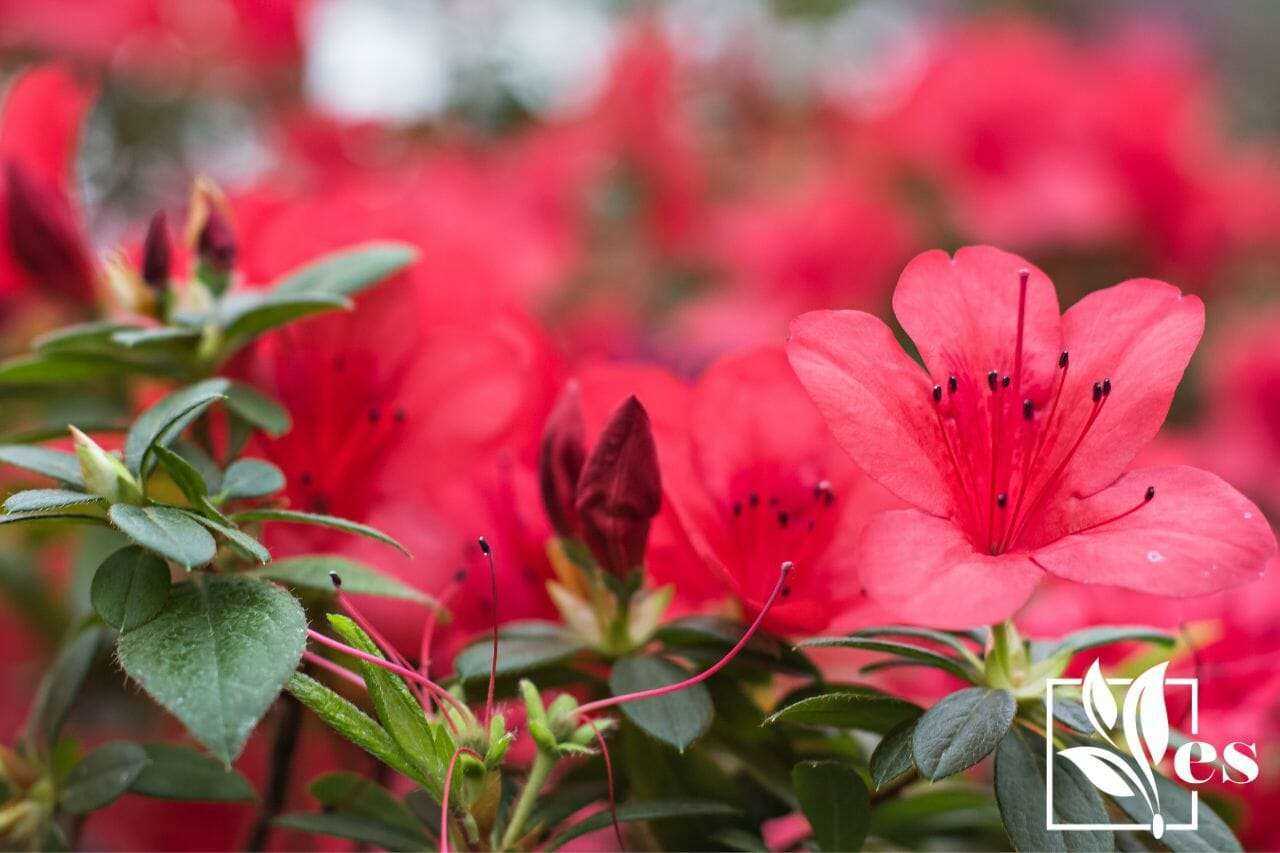
Avoid transplanting during extreme hot or cold months, as this can put undue stress on the azaleas and hinder their ability to establish in the new location. If possible, choose a time when temperatures are moderate.
Plan Around Blooming
If you want to transplant azaleas when they are in bloom, try to do so right after the flowers have faded. This will allow the plants to recover and focus their energy on establishing roots rather than producing blooms.
Consider Local Climate
Take into account the local climate and weather patterns when choosing the right time to transplant azaleas. Research the average frost dates and climate conditions in your area to make an informed decision.
Consult a Gardening Expert
If you are unsure about the best time to transplant azaleas in your specific location, consult a gardening expert or a local nursery. They will have knowledge and experience specific to your area and can provide valuable guidance.
By choosing the right time to transplant your azaleas, you increase the chances of their success and ensure their long-term health in their new location.
Locating the New Spot
When choosing a new spot for your transplanted azaleas, there are a few important factors to consider:
- Light: Azaleas prefer partial shade, so look for an area that receives dappled sunlight or morning sun with afternoon shade.
- Soil: Azaleas thrive in acidic soil with good drainage. Test the soil pH and amend it if necessary to ensure it falls between 4.5 and 6.0.
- Space: Make sure the new spot provides enough space for the azaleas to grow. Consider both their current size and their potential growth in the coming years.
- Proximity: Consider placing the azaleas near other plants with similar moisture and sun requirements to create a visually appealing and harmonious garden.
Once you have considered these factors, mark the new spot for transplantation and prepare it before moving the azaleas.
Preparing the New Location
Transplanting azaleas requires careful planning and preparation to ensure the new location provides the right conditions for their growth and blooming. Follow these steps to prepare the new location:
- Choose the right spot: Select a location that offers partial shade to protect the azaleas from direct sunlight during the hottest parts of the day. Azaleas prefer acidic soil, so make sure the spot has a pH between 4.5 and 6.0.
- Clear the area: Remove any existing vegetation, rocks, or debris from the new location. Azaleas need space to spread their roots, so ensure the area is clear and free from obstructions.
- Prepare the soil: Test the soil pH and make adjustments if necessary to achieve the ideal acidic conditions. Work in organic matter, such as peat moss or compost, to improve drainage and provide nutrients for the azaleas.
- Amend the soil: Add any necessary amendments, such as sulfur or iron sulfate, to lower the pH if it is too high. Follow the instructions on the product packaging for the correct application rates.
- Provide drainage: Azaleas require well-draining soil to prevent waterlogged roots. If the soil in the new location is heavy or clayey, consider creating a raised bed or adding organic matter to improve drainage.
- Consider spacing: Plan the spacing of your azaleas based on their mature size. Allow enough room for the plants to grow and spread without overcrowding. Typically, spacing them 3 to 6 feet apart is recommended.
- Mark the planting holes: Use stakes or flags to mark the spots where you will dig the planting holes. This will help you visualize the layout of the plants and ensure they are evenly spaced.
By taking the time to properly prepare the new location, you can provide the best possible conditions for your transplanted azaleas to thrive and flourish.
Removing the Azalea from its Current Spot
Before transplanting an azalea, it is important to carefully remove it from its current spot. This process should be done with caution to minimize damage to the plant’s roots and ensure its successful transplantation.
Step 1: Choose the right time
Avoid transplanting azaleas during periods of active growth, such as spring or early summer. Instead, aim to transplant them in the fall or late winter when the plant is dormant. This will reduce stress on the plant and increase its chances of survival.
Step 2: Prepare the new location
Before removing the azalea, prepare a suitable new location for it. Choose a spot with well-draining soil and partial shade. Clear any weeds or grass from the area and dig a hole that is slightly wider and deeper than the plant’s root ball.
Step 3: Water the azalea
To ensure that the azalea is well-hydrated before transplanting, thoroughly water it a day or two before the planned removal. This will help to keep the roots moist and reduce stress during the transplantation process.
Step 4: Prune the azalea
Before removing the azalea from its current spot, prune the shrub to reduce its size and remove any dead or damaged branches. This will help to promote new growth and minimize stress on the plant.
Step 5: Dig around the root ball
Carefully dig around the base of the azalea, using a sharp spade or shovel to loosen the soil. Start digging approximately 12 inches away from the trunk, working your way inward to create a circular trench. Be gentle to avoid damaging the plant’s roots.
Step 6: Lift the azalea
Once the root ball is fully exposed, gently lift the azalea from the ground. Take care to support the bottom of the root ball to prevent it from falling apart or breaking. If necessary, have someone assist you in lifting the plant to avoid strain or injury.
Step 7: Inspect the roots
Take a moment to inspect the azalea’s roots for any signs of damage or disease. Trim any damaged or circling roots using clean pruning shears. This will promote healthy growth and reduce the risk of transplant shock.
Step 8: Wrap the root ball
Once the roots have been inspected, gently wrap the root ball in burlap or a plant bag to protect it during transportation. Be sure to secure the wrap tightly but not too tightly to avoid damaging the roots.
Step 9: Transport the azalea
With the root ball securely wrapped, transport the azalea to its new location as quickly as possible. Avoid exposing the roots to excessive heat or cold during transit.
Step 10: Plant the azalea
Upon reaching the new location, carefully lower the azalea into the prepared hole. Position the plant so that the top of the root ball is level with or slightly above the ground. Backfill the hole with soil, gently firming it around the roots as you go.
By following these steps, you can successfully remove an azalea from its current spot and transplant it to a new location. Remember to take your time and handle the plant with care to ensure its continued health and growth.
Transplanting the Azalea
Transplanting an azalea can be a delicate process, but with the right steps, it can be done successfully. Follow these instructions to ensure a smooth transition for your azalea:
1. Choose the right time
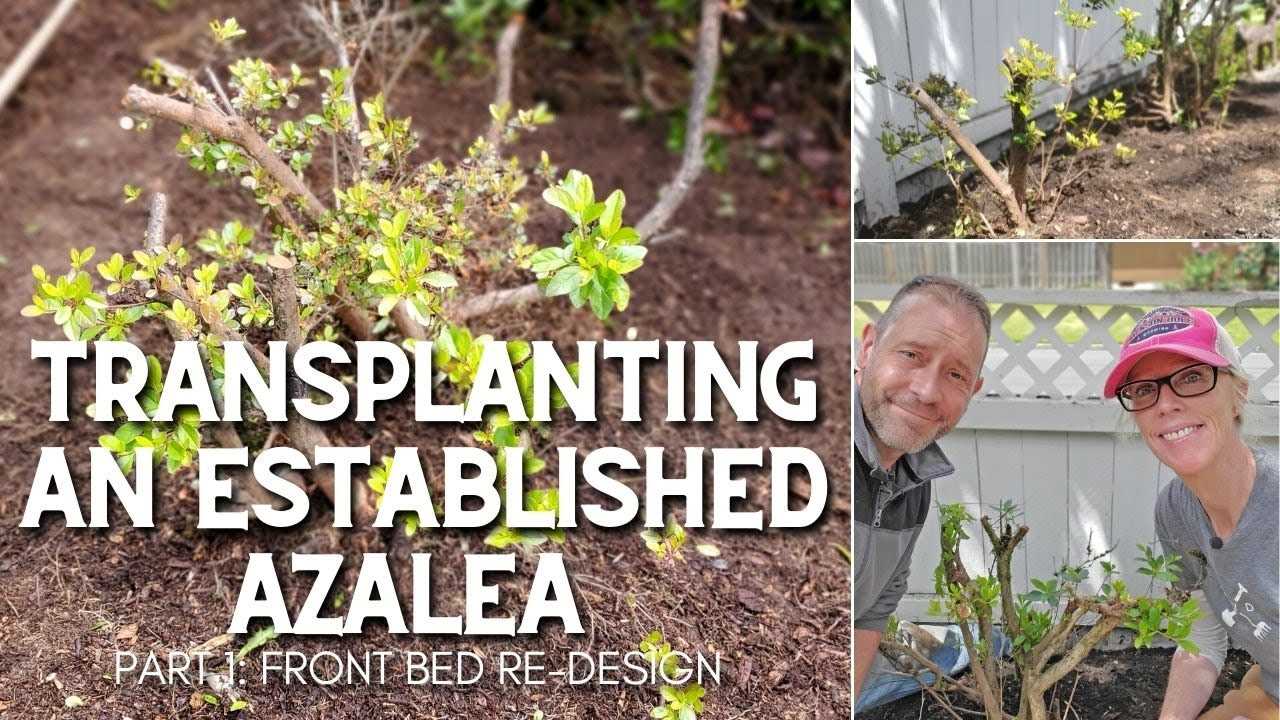
It’s best to transplant azaleas in early spring or late fall when the weather is mild and the plant is dormant. Avoid transplanting during hot summer months or freezing winter conditions.
2. Prepare the new location
Before transplanting, make sure the new location is suitable for the azalea. It should have well-drained soil, partial shade, and protection from strong winds. Dig a hole that is twice the size of the root ball.
3. Water the azalea
Water the azalea thoroughly a day or two before transplanting. This will help loosen the soil around the roots and make it easier to remove the plant without damaging the roots.
4. Dig up the azalea
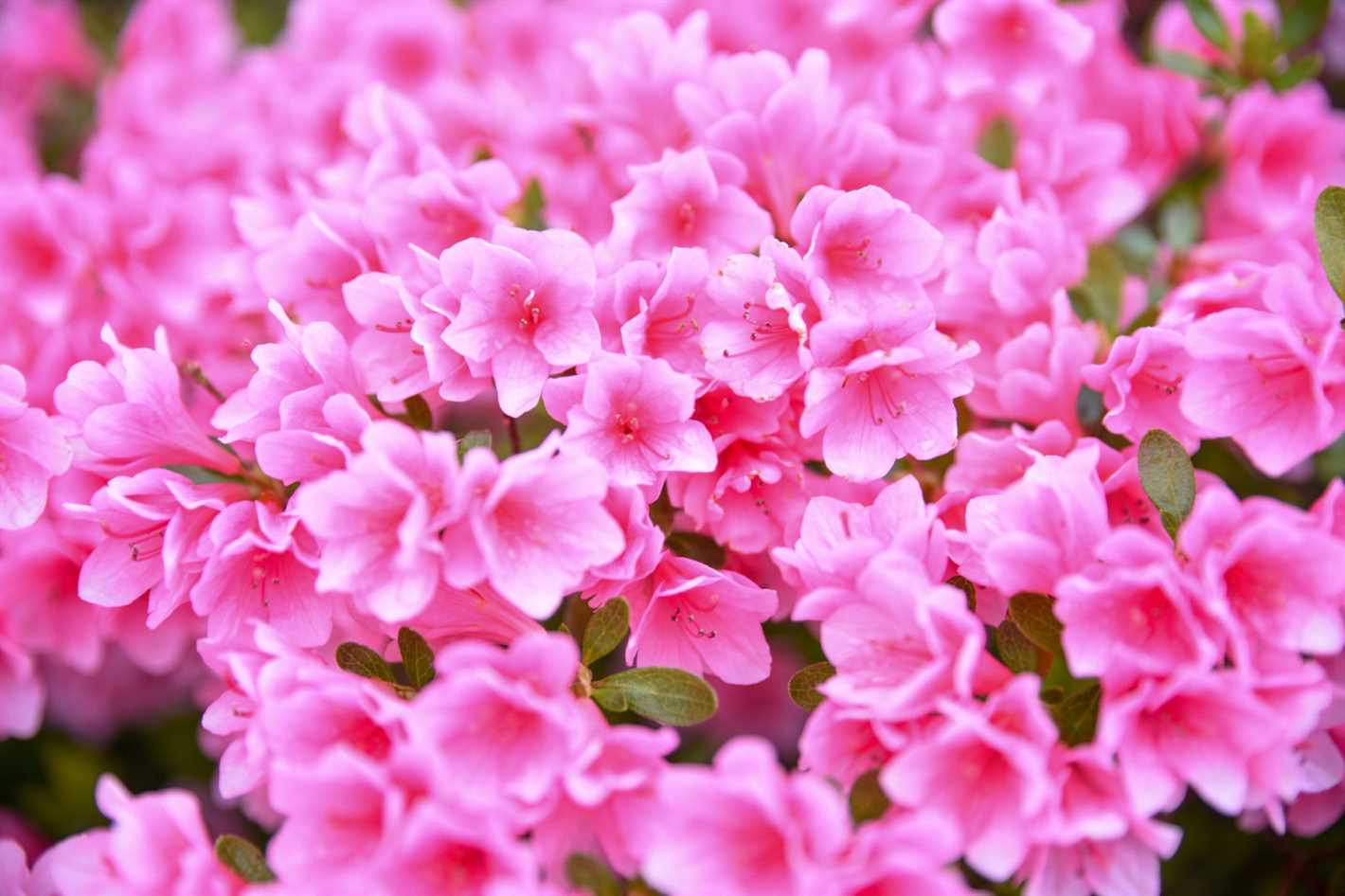
Using a shovel or garden fork, carefully dig around the base of the azalea to loosen the roots. Lift the plant out of the ground, being sure to keep as much of the root ball intact as possible.
5. Transplant the azalea
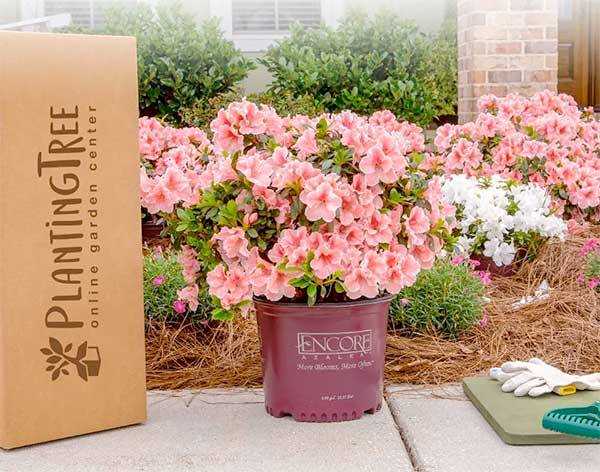
Place the azalea into the prepared hole in the new location. Position it so that the top of the root ball is level with the surrounding soil. Fill in the hole with a mixture of soil and compost, gently firming it down around the roots.
6. Water and mulch
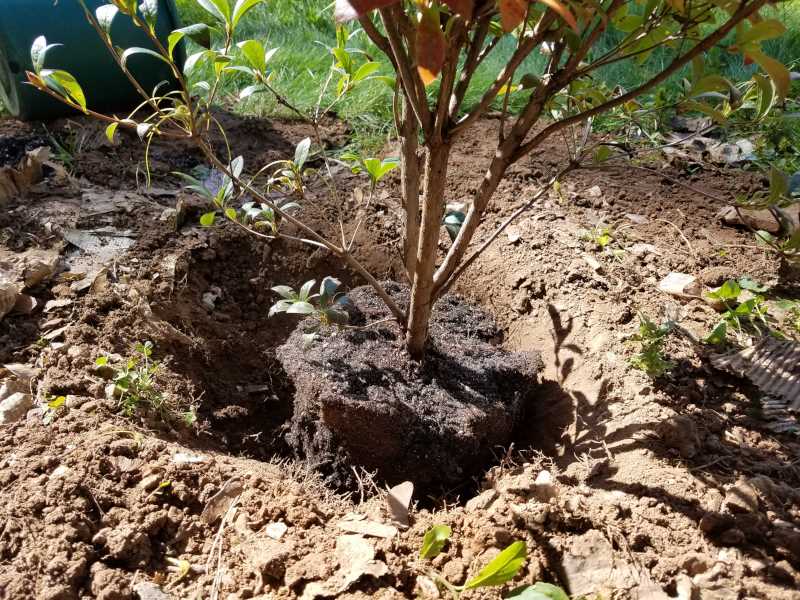
Water the transplanted azalea thoroughly after planting to help settle the soil. Apply a layer of mulch around the base of the plant to help retain moisture and suppress weed growth.
7. Monitor and care for the azalea

Keep a close eye on the transplanted azalea for the first few weeks after transplanting. Water regularly to keep the soil moist but not waterlogged. Provide shade or cover if there are extreme weather conditions.
Remember, successful transplanting depends on proper preparation and care. By following these steps, you can ensure a smooth transition for your azalea and promote its healthy growth in its new location.
Caring for the Transplanted Azalea
Once you have successfully transplanted your azalea, it is important to provide proper care to ensure its health and growth in its new location. Follow these steps to care for your newly transplanted azalea:
1. Watering
Water the azalea thoroughly immediately after transplanting to help settle the soil and reduce stress on the plant. Keep the soil moist but not waterlogged for the first few weeks. Water regularly, especially during dry periods, to establish a healthy root system.
2. Mulching
Apply a layer of organic mulch around the base of the azalea, leaving a gap around the trunk to prevent moisture buildup. Mulch helps retain soil moisture, suppresses weeds, and insulates the roots from temperature extremes.
3. Fertilizing
Avoid fertilizing the azalea for the first year after transplanting. The plant needs time to establish its root system before it can efficiently absorb nutrients. After the first year, apply a balanced, slow-release fertilizer specifically formulated for azaleas according to the manufacturer’s instructions.
4. Pruning
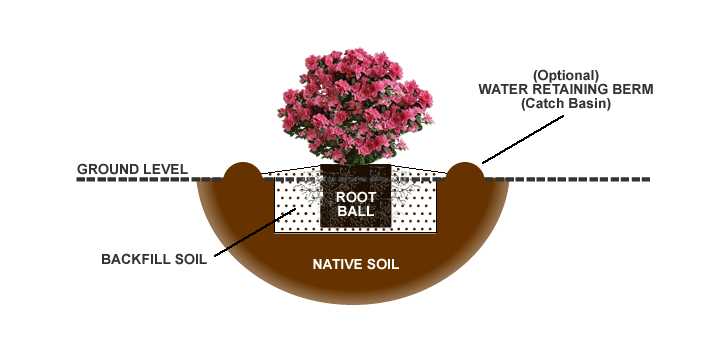
Prune any dead or damaged branches from the azalea after transplanting. Avoid heavy pruning until the plant has fully recovered and started to grow in its new location. Light pruning can be done in the following years to shape the plant and remove any unwanted growth.
5. Protection
Protect the azalea from extreme weather conditions, such as frost or strong winds. Cover the plant with a frost cloth or move it to a sheltered area if necessary. Avoid planting azaleas in exposed locations where they are more susceptible to damage.
6. Monitoring
Regularly monitor the azalea for signs of stress or pest infestation. Look for yellowing or wilting leaves, pests like aphids or spider mites, or any other signs of trouble. Early detection can help you address any issues before they become more serious.
By following these care guidelines, your transplanted azalea should thrive in its new location. Remember to be patient and allow the plant time to adjust and establish its roots. With proper care, your azalea will reward you with beautiful blooms for years to come.
Monitoring and Troubleshooting
Once you have successfully transplanted your azaleas, it is important to monitor their progress and address any issues that may arise. Here are some tips for monitoring and troubleshooting:
1. Regularly check soil moisture:
- Make sure the soil around the transplant is consistently moist, but not waterlogged.
- Stick your finger in the soil to test its moisture level. If it feels dry, water the plant thoroughly.
2. Watch out for signs of stress:
- If the leaves of your azaleas start turning yellow or drooping, it may indicate that the plant is experiencing stress.
- Monitor the foliage for any signs of wilting, discoloration, or unusual growth patterns.
3. Provide appropriate sunlight:
- Azaleas require partial shade to thrive. Too much direct sunlight can cause the leaves to burn, while insufficient light can result in poor growth.
- Monitor the position of the plant throughout the day to ensure it is receiving the right amount of sunlight.
4. Prune damaged or dead branches:
- If you notice any dead or damaged branches on your azaleas, prune them off using sharp, sterile pruning shears.
- Removing these branches will promote healthier growth and prevent the spread of diseases.
5. Keep an eye out for pests and diseases:
- Inspect your azaleas regularly for any signs of pests, such as aphids, spider mites, or caterpillars.
- If you notice any pests, treat them with appropriate insecticidal soap or other organic pest control methods.
- Also, watch for signs of diseases like powdery mildew or leaf spot. If identified, take necessary measures to treat the affected plants.
6. Mulch the soil:
- Apply a layer of organic mulch, such as wood chips or pine needles, around the base of the transplanted azaleas.
- Mulching helps retain moisture, regulate soil temperature, and suppress weed growth.
By closely monitoring your transplanted azaleas and addressing any issues promptly, you can help ensure their successful establishment and growth in their new location.
Q&A:
Why would I need to transplant azaleas?
There are several reasons why you might need to transplant azaleas. Maybe they have outgrown their current location and need more space to thrive, or perhaps you are moving and want to take them with you. Transplanting azaleas can also be a way to rejuvenate an older plant that is not flowering as well as it used to.
When is the best time to transplant azaleas?
The best time to transplant azaleas is in the early spring or late fall. This is when the plants are dormant and will experience less stress from being moved. Avoid transplanting them during the hot summer months, as they may struggle to establish themselves in the heat.
How do I prepare the new planting location for the azaleas?
Before transplanting azaleas, you should prepare the new planting location. This involves choosing a spot that receives partial shade, as azaleas prefer filtered sunlight. The soil should be well-drained and slightly acidic, with a pH between 4.5 and 6.0. You may need to amend the soil with organic matter to improve its drainage and fertility.
How should I dig up the azalea for transplanting?
When digging up the azalea for transplanting, start by watering the plant thoroughly a day or two before. This will help loosen the root ball and make it easier to remove. Use a sharp shovel or garden fork to carefully dig around the plant, making sure to capture as much of the root system as possible. Lift the azalea out of the ground, keeping the root ball intact.
What should I do after transplanting the azaleas?
After transplanting the azaleas, it is crucial to water them thoroughly to help settle the soil and eliminate air pockets around the roots. Apply a layer of mulch around the base of the plant to conserve moisture and regulate soil temperature. Keep the newly transplanted azaleas well-watered for several weeks to promote root establishment, and avoid fertilizing them until they have had time to adjust to their new home.
Video:
How to Propagate Azaleas From Cuttings in Water: Grow Azalea Cuttings In Water







